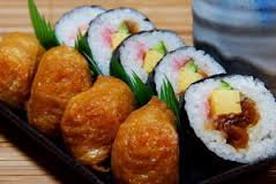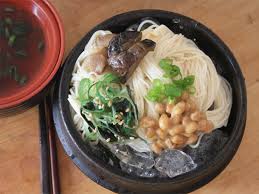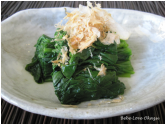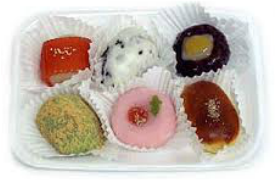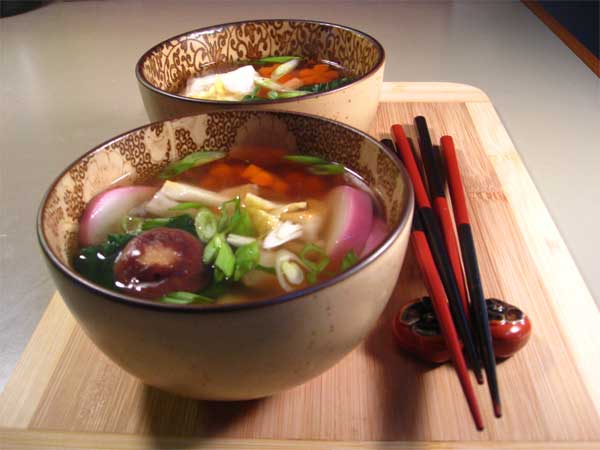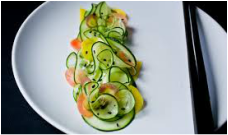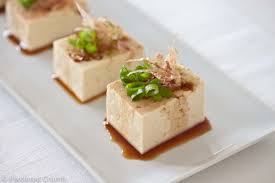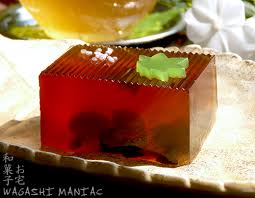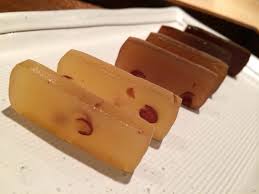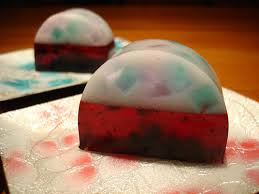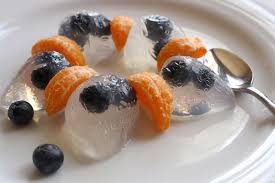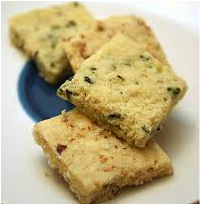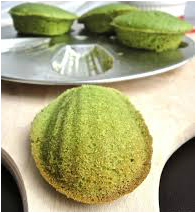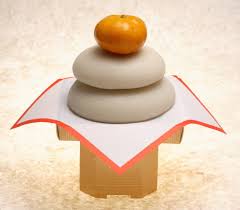
In Japan, the New Year is celebrated on January 1, as it is in the western world. Traditionally, New Year’s Day in Japan is a time for paying debts from the previous year, reconciling any conflicts, visiting friends and relatives and enjoying special foods, especially ozoni, the unique New Year’s soup. Very traditional Japanese families make their own mochi, sticky rice dumplings that are the key ingredient in ozoni soup, guaranteed to keep you healthy and strong during the upcoming year. Mochi is created by pounding glutinous rice into a sticky pulp that is then shaped into small flat discs. Fortunately, mochi is readily available in Japanese markets throughout the United States, especially just before the New Year.
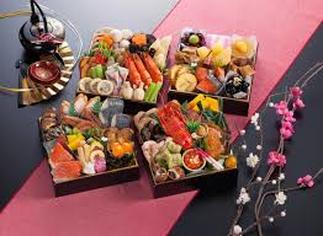
Our Japanese New Year’s tea can be presented as a help-yourself buffet, as it is served in Japanese American families where friends and relatives drop in throughout the day. Or, you can adapt this special meal to the English style format, serving it in individual courses with hot green tea as the beverage of choice. Many of the foods in our menu can be purchased easily at a Japanese deli or grocery store, but ozoni soup is very easy to make, and you might enjoy creating this iconic Japanese New Year’s specialty yourself. Our menu is a sampling of the items that might be served at a Japanese family New Year’s celebration. When you get to the Japanese market, feel free to select whatever looks good, but go early because Japanese groceries are madhouses the day before New Year.
Menu
Beverages:
Green Tea
Japanese Beer, such as Sapporo or Asahi
Savories:
Ozoni Soup (Japanese New Year’s Soup with Rice Dumplings)
Sushi Assortment
(Futomaki--seaweed wrapped rolled sushi with vegetable filling,
Inarizushi—cone shaped sushi wrapped in pockets of fried tofu, California Roll, etc.)
Cold Tofu Topped with Fresh Ginger and Bonito Flakes
Somen (Cold Noodle Salad)
Pickled Cucumber Salad (Cucumber Namasu)
Japanese Pickles (Tsukemono)
Seasoned Burdock Root (Kimpira Gobo)
Seasoned Spinach (Spinach no Oshitashi)
Teriyaki Chicken
Teriyaki Salmon
Barbecued Spare Ribs
Sweets:
Assorted Manju (Japanese Pastries Filled with Sweetened Bean Paste)
Kanten (Flavored Gelatin Cubes)
Shortbread Cookies or French Pastries (Yes, the Japanese love western-style desserts, especially delicate cookies, thinly sliced pound cake and petites fours.)
Beverages:
Green Tea
Japanese Beer, such as Sapporo or Asahi
Savories:
Ozoni Soup (Japanese New Year’s Soup with Rice Dumplings)
Sushi Assortment
(Futomaki--seaweed wrapped rolled sushi with vegetable filling,
Inarizushi—cone shaped sushi wrapped in pockets of fried tofu, California Roll, etc.)
Cold Tofu Topped with Fresh Ginger and Bonito Flakes
Somen (Cold Noodle Salad)
Pickled Cucumber Salad (Cucumber Namasu)
Japanese Pickles (Tsukemono)
Seasoned Burdock Root (Kimpira Gobo)
Seasoned Spinach (Spinach no Oshitashi)
Teriyaki Chicken
Teriyaki Salmon
Barbecued Spare Ribs
Sweets:
Assorted Manju (Japanese Pastries Filled with Sweetened Bean Paste)
Kanten (Flavored Gelatin Cubes)
Shortbread Cookies or French Pastries (Yes, the Japanese love western-style desserts, especially delicate cookies, thinly sliced pound cake and petites fours.)
|
Recipes Included:
Japanese New Year’s Soup (Ozoni) Ozoni is a fresh, clear soup that should be served shortly after it is made. You can make the broth a couple of hours before your guests arrive and add the fresh vegetables and mochi at the last minute. Serve each guest an individual bowl of soup with one mochi dumpling per bowl. If you expect more than eight guests, get enough ingredients to make a second batch. Like all Japanese cuisine, this dish is designed to be visually appealing as well as delicious. The carrots, green onions and mizuna should retain their bright coloring. Seasoned Burdock Root (Kimpira Gobo) Burdock root, called gobo in Japanese, is available in Japanese markets. It is not a pretty vegetable; burdock root looks a bit like a giant tan carrot on steroids. In addition, the exterior needs to be scrubbed, scraped and peeled before the root is meticulously cut into matchstick sized pieces for this preparation. Try to get a very patient family member to volunteer for this task. It will be worth the effort, as spiced gobo, which can be served at room temperature, is a subtle delight not to be missed. Cucumber Namasu (Pickled Cucumber Salad) This refreshing salad can be made in advance and refrigerated until guests arrive. The cucumbers are deliberately wilted, so there is no worry about keeping them crisp. You can add a little grated carrot for color if you wish, or dress this humble preparation up by adding flaked crabmeat. Cold Tofu Topped with Fresh Ginger and Bonito Flakes This wonderful dish is the easiest food item of all time to prepare. It requires no cooking of any kind and makes a lovely presentation on the buffet table. Use a shallow, colorful imari style bowl if you have one to contrast with the white color of the tofu. Kanten (Flavored Gelatin Cubes) It is not customary in Japan to serve dessert immediately after a meal, but the Japanese still love their sweets. Pastries, ice cream creations, ices and gelatins are more likely to be enjoyed in Japan as afternoon treats with coffee or tea. They are also served at home whenever guests arrive, and sweets are a popular form of omiyage, the ubiquitous host or hostess gifts which are presented whenever visiting, either for social or business purposes. Visitors to Japan are stunned by the sophistication and elegance evident in the Japanese pastry industry. Entire floors of enormous department stores are devoted to elaborately decorated and packaged boxes of pastries, both Japanese and European in style. Individual pastry shops also offer their own unique pastries, decorated according to the season of the year. The most popular traditional Japanese dessert is manju, which is an individual pastry comprised of sweetened bean filling surrounded by a mochi rice or flour based coating, often intricately decorated with images of seasonal fruits or flowers. Because the creation of manju is a highly evolved professional art form, we do not recommend trying to make manju at home. Fortunately, manju is readily available in Japanese grocery stores, department stores and pastry shops in the United States and Canada. We think you will enjoy visiting one of these shops and picking out just the right assortment of manju for your Japanese New Year buffet table. A simpler Japanese sweet is Kanten, slices or cubes of very thick gelatin, sweetened and flavored with fruit juice. Kanten is really finger food, which, because of its high gelatin content, does not need refrigeration and is thus perfect buffet food. Children love helping themselves to Kanten. Japanese American housewives of the Nisei (second) generation often made Kanten at home, using Jello and even Kool-Aid for flavoring. We found a recipe using both in a church cookbook entitled Nisei Favorites published in Gardena, California, around 1966. We have taken the liberty of updating this recipe, submitted by Mrs. Ruby Kashiwagi of Los Angeles, by adding fresh orange juice instead of Kool-Aid, but we kept the Jello for its intense color. Black Sesame Seed Shortbread Cookies Black Sesame Seeds are called kuro goma in Japanese, and they appear in all sorts of Japanese foods, both sweet and savory. While this Shortbread recipe is not Japanese, it is Japaneseish in the sense that it combines the very popular Black Sesame Seeds with the also popular Shortbread Cookies. Who could object to this charming partnership? Green Tea (Matcha) Madeleines Like the Black Sesame Seed Shortbread Cookies, these Green Tea Madeleines are not Japanese. However, they do reflect the Japanese passion for all things French, from the Impressionist Painters to fine French pastries. And matcha (powdered green tea) has been used in the Japanese Tea Ceremony for centuries. We think these green madeleines will make a visually attractive and very tasty addition to the Japanese New Year’s Buffet. |




